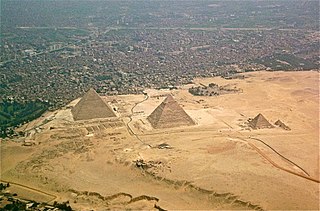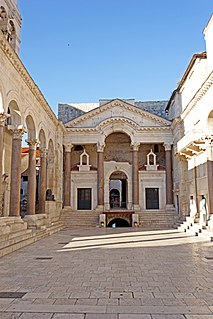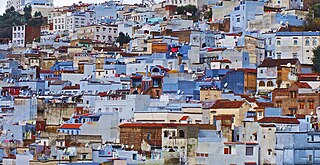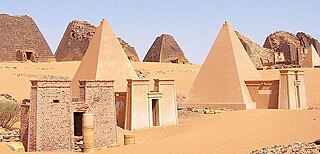
A pyramid is a structure whose outer surfaces are triangular and converge to a single step at the top, making the shape roughly a pyramid in the geometric sense. The base of a pyramid can be trilateral, quadrilateral, or of any polygon shape. As such, a pyramid has at least three outer triangular surfaces. The square pyramid, with a square base and four triangular outer surfaces, is a common version.

Sudano-Sahelian architecture refers to a range of similar indigenous architectural styles common to the African peoples of the Sahel and Sudanian grassland (geographical) regions of West Africa, south of the Sahara, but north of the fertile forest regions of the coast.
Yaa Naa Yakubu Andani II (1945–2002) was the King of Dagbon, the traditional kingdom of the Dagomba people in northern Ghana, from 31 May 1974 until his assassination on 27 March 2002. He was born in August 1945 in Sagnarigu, a suburb of Tamale in the Northern Region of Ghana. Yakubu II was killed on 27 March 2002 at Yendi, the capital of the Kingdom of Dagbon, by unknown people when clashes broke out between the two feuding Gates of Dagbon Kingship. For 600 years the Abudu and Andani clans, named after two sons of the ancient Dagbon king Ya Naa Yakubu I, cordially rotated control of the kingdom centred in Yendi, 530 kilometres (330 mi) north of Accra, the capital of Ghana. As of January 2014, a regent has acted as sovereign of the kingdom until 18 January 2019 when a new ruler is chosen to occupy the revered Lion Skins of Yendi.
The Dagombas are a Gur ethnic group of northern Ghana, numbering more than 2.3 million people. They inhabit the Northern Region of Ghana in the sparse savanna region below the sahelian belt, known as the Sudan. They speak the Dagbani language which belongs to the Mole-Dagbani sub-group of the Gur languages. There are around 1 to 2 million speakers of Dagbani. The Dagomba are historically related to the Mossi people. The Mohi/Mossi now have their homeland in central present-day Burkina Faso. The homeland of the Dagomba is called Dagbon and covers about 20,000 km2 in area.

The Upper West Region of Ghana is located in the north-western corner of Ghana and is bordered by Upper East region to the east, Northern region to the south, and Burkina Faso to the west and north. The Upper West regional capital and largest settlement is Wa. The Upper West was created by the then Head of State, Flight-Lieutenant Jerry Rawlings in 1983 under the Provisional National Defense Council (PNDC) military regime. The area was carved out of the former Upper Region, which is now the Upper East Region. For about thirty-five years, it remained the youngest region of Ghana until 2018 when six more regions were created by the Nana Addo Dankwa Akufo-Addo government; hence increasing the total number of administrative regions in the country to sixteen.

Diocletian's Palace is an ancient palace built for the Roman emperor Diocletian at the turn of the fourth century AD, which today forms about half the old town of Split, Croatia. While it is referred to as a "palace" because of its intended use as the retirement residence of Diocletian, the term can be misleading as the structure is massive and more resembles a large fortress: about half of it was for Diocletian's personal use, and the rest housed the military garrison.

Moroccan architecture refers to the architecture characteristic of Morocco throughout its history and up to modern times. The country's diverse geography and long history, marked by successive waves of settlers through both migration and military conquest, are all reflected in its architecture. This architectural heritage ranges from ancient Roman and Berber (Amazigh) sites to 20th-century colonial and modern architecture.

Like other aspects of the culture of Africa, the architecture of Africa is exceptionally diverse. Throughout the history of Africa, Africans have developed their own local architectural traditions. In some cases, broader regional styles can be identified, such as the Sudano-Sahelian architecture of West Africa. A common theme in traditional African architecture is the use of fractal scaling: small parts of the structure tend to look similar to larger parts, such as a circular village made of circular houses.

Qasr Ibn Wardan is a hamlet and 6th-century archaeological site located in the Syrian Desert, approximately 60 kilometres (37 mi) northeast from Hama and about 19 kilometres (12 mi) northeast of al-Hamraa. The hamlet is separated from the Byzantine-era ruins by a road, with the former situated to the east of the road and the ruins situated to the west. According to the Syria Central Bureau of Statistics (CBS), Qasr Ibn Wardan had a population of 467 in the 2004 census.

The Aqueduct of Segovia is a Roman aqueduct in Segovia, Spain. It is one of the best-preserved elevated Roman aqueducts and the foremost symbol of Segovia, as evidenced by its presence on the city's coat of arms.
The Wala or Waala live in Upper West Region of Ghana. They are a predominantly Muslim people who are the founders of the city of Wa and the Kingdom of Wala. They speak the Wali language, which belongs to the Gur group. There are 84,800 speakers of the language as of 2013. Their neighbors are the Birifor, Dagaaba, and Vagla peoples.
Peter Tenganabang Nanfuri is the Paramount Chief of the Jirapa Traditional Area with the title Naa Ansoleh Ganaa II. He is a former Inspector General of Police (IGP) in Ghana.
Whispering rocks and Shrines of Tongo is found in Tengzug village, Ghana. The Rocks are famous for its arrangement where one rock comfortably sits on another. The rocks are also known for making strange whistling sounds in November and December of every year.

Nakore Mosque is a mosque built in the Sudanese architectural style in the village of Nakore, southwest of Wa in the Upper West region of Ghana. It is a small mosque.
Wechiau Mosque is a mosque built in the Sudanese architectural style and Djenne style in the village of Wechiau in the Upper West region of Ghana. It has similar features as the Larabanga mosque.
Wuriyanga Mosque is located in the Upper East region of Ghana, beyond Garu. It is located southeast of Bawku.

Bole Mosque is located in the center of Bole in the West Gonja District which is now in the Savannah region, formally Northern region in Ghana.
Banda Nkwanta Mosque is located in the West Gonja District in the formally Northern region of Ghana. It is now in the Savannah region. Banda Nkwanta is a small town along the intersection of the Bui Dam road and the Wa-Techiman highway.
Dumba Festival is an annual festival celebrated by the chiefs and people of Wa of the Wala Paramouncy in the Upper West Region of Ghana. It is usually celebrated in the month of September or October.

The architecture of Sudan mirrors the geographical, ethnic and cultural diversity of the country and its historical periods. The lifestyles and material culture expressed in human settlements, their architecture and economic activities have been shaped by different regional and environmental conditions. In its long documented history, Sudan has been a land of changing and diverse forms of human civilization with important influences from foreign cultures.











